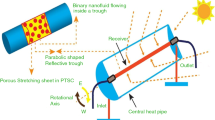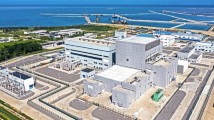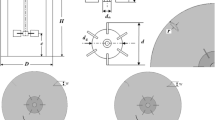Abstract
Results of the experimental research on gas hold-up, power consumption for liquid phase and gas—liquid systems, and on residence time of the gas bubbles are presented in the paper for an agitated vessel with a turbine impeller. Distilled water or aqueous solutions of NaCl were used as the liquid phase. Air was dispersed into liquid as the gas phase. The studies were carried out in an agitated vessel of the inner diameter D = 0.634 m. Tubular baffles of the diameter of 0.7D, consisting of 24 vertical tubes of the diameter of 0.016D, were located inside a flat-bottomed tank. Turbines with six blades and the pitch of 90°, 60°, or 45°, respectively, were used for agitation. Measurements were carried out in the range of good dispersion of gas bubbles in the liquid within the turbulent regime of the liquid flow. Effects of the gas bubbles capability to coalesce on the gas hold-up, residence time of the gas bubbles, and power consumption were analyzed. Results of the power consumption (P G-L /P o = f 1(Kg, Fr)) and gas hold-up (φ= f 2(Kg, We, Y)) were approximated mathematically, using Eqs. (5) and (6), respectively. In Eq. (6), parameter Y was introduced in order to describe the influence of the bubbles capability to coalesce on the gas hold-up. The results of the study show that power consumption does not depend on the capability of bubbles to coalesce, but the pitch of the turbine impeller affects the power characteristics in such a physical system significantly. However, the residence time of the gas phase in agitated liquid depends on the pitch of the impeller blade and on the capability of bubbles to coalesce.
Similar content being viewed by others
References
Ankamma Rao, D., & Sivashanmugam, P. (2010). Experimental and CFD simulation studies on power consumption in mixing using energy saving turbine agitator. Journal of Industrial and Engineering Chemistry, 16, 157–161. DOI: 10.1016/j.jiec.2010.01.002.
Dunlap, I. R., & Rushton, J. H. (1953). Heat transfer coefficients in liquid mixing vertical tube baffles. Chemical Engineering Progress, 49(5), 137–151.
Harnby, N., Edwards, M. F., & Nienow, A. W. (1997). Mixing in the process industries. Oxford, UK: Butterworth.
Karcz, J., & Major, M. (2001a). Experimental studies of heat transfer in an agitated vessel equipped with vertical tubular coil. Inżzynieria Chemiczna i Procesowa, 22, 445–459.
Karcz, J., & Major, M. (2001b). Heat transfer in an agitated vessel equipped with vertical tubular coil. Inżzynieria Chemiczna i Procesowa, 22, 639–644. (in Polish)
Karcz, J., & Major, M. (1998). An effect of a baffle length on the power consumption in an agitated vessel. Chemical Engineering and Processing, 37, 249–256. DOI: 10.1016/S0255-2701(98)00033-6.
Karcz, J., Stręk, F., Major, M., & Michalska, M. (2002). An efficiency of the heat transfer process in an agitated vessel equipped with a vertical tubular coil. In Proceedings of the 15th International Congress CHISA, August 25–29 2002 (paper P5.150, 8 pp.). Prague, Czech Republic.
Karcz, J., Stręk, F., Major, M., & Siciarz, R. (1998). An effect of the geometrical parameters of the tubular baffles on a power consumption in the agitated vessel. In Proceedings of the 13th International Congress CHISA, August 23–28 1998 (paper P1.29, 9 pp.). Prague, Czech Republic.
Lee, J. C., & Meyrick, D. L. (1970). Gas-liquid interfacial areas in salt solutions in an agitated tank. Transactions of the Institution of Chemical Engineers, 48, T37–T45.
Machoň, V., Vlček, J., & Kudrna, V. (1978). Gas hold-up in agitated aqueous solutions of strong inorganic salts. Collection of Czechoslovak Chemical Communications, 43, 593–603.
Major, M. (2000). Studies on the heat transfer from the vertical coil to the pseudoplastic liquid stirred in a tank with the rotating agitator. PhD Thesis, Technical University of Szczecin, Szczecin, Poland.
Major-Godlewska, M. (2003). Experimental studies of gas holdup and power consumption in an agitated vessel equipped with a vertical coil. Inżzynieria i Aparatura Chemiczna, 42(5), 125–127. (in Polish)
Major-Godlewska, M., & Karcz, J. (2003). Gas hold-up and power consumption for gas-liquid system agitated in a stirred tank equipped with vertical coil. Chemical Papers, 57, 432–444.
Man, K. L., Hughes, W., & Moody, G. W. (1991). The effect of rheology and baffle design on the power and heat transfer performance in stirred vessels using vertical tubular baffles. In Proceedings of the 7th European Conference on Mixing, September 18–20 1991 (Part I, pp. 321-332). Brugge, Belgium.
Michalska, M. (2001). Heat transfer in a stirred tank equipped with the vertical tubular coil and rotating agitator. PhD Thesis, Technical University of Szczecin, Szczecin, Poland.
Paul, E. L., Atiemo-Obeng, V. A., & Kresta, S. M. (2004). Handbook of industrial mixing. Hoboken, NJ, USA: Wiley-Interscience.
Sivashanmugam, P., & Prabhakaran, S. (2008). Simulation of an effect of a baffle length on the power consumption in an agitated vessel. International Journal of Food Engineering, 4(2), article 3. DOI: 10.2202/1556-3758.1320.
Sivashanmugam, P., & Sandeep, P. (2009). Experimental studies and CFD modeling on the effects of a cut in the baffle on power consumption. Chemical Product and Process Modeling, 4(1), article 5. DOI: 10.2202/1934-2659.1340.
Stręk, F. (1981). Agitation and agitated vessels. Warsaw, Poland: WNT. (in Polish)
Tatterson, G. B. (1991). Fluid mixing and gas dispersion in agitated tanks. New York, NY, USA: McGraw-Hill.
Torré, J.-P., Fletcher, D. F., Lasuye, T., & Xuereb, C. (2007). An experimental and computational study of the vortex shape in a partially baffled agitated vessel. Chemical Engineering Science, 62, 1915–1926. DOI: 10.1016/j.ces2006.12.020.
Zadghaffari, R., Moghaddas, J. S., & Revstedt, J. (2010). Largeeddy simulation of turbulent flow in a stirred tank driven by Rushton turbine. Computers & Fluids, 39, 1183–1190. DOI: 10.1016/j.compfluid.2010.03.001.
Author information
Authors and Affiliations
Corresponding author
Rights and permissions
About this article
Cite this article
Major-Godlewska, M., Karcz, J. Process characteristics for a gas—liquid system agitated in a vessel equipped with a turbine impeller and tubular baffles. Chem. Pap. 65, 132–138 (2011). https://doi.org/10.2478/s11696-010-0080-0
Received:
Revised:
Accepted:
Published:
Issue Date:
DOI: https://doi.org/10.2478/s11696-010-0080-0




